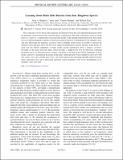| dc.contributor.author | Hughes, Scott A | |
| dc.contributor.author | Apte, Anuj | |
| dc.contributor.author | Khanna, Gaurav | |
| dc.contributor.author | Lim, Halston | |
| dc.date.accessioned | 2022-01-12T16:57:50Z | |
| dc.date.available | 2021-10-27T20:35:43Z | |
| dc.date.available | 2022-01-12T16:57:50Z | |
| dc.date.issued | 2019 | |
| dc.identifier.uri | https://hdl.handle.net/1721.1/136506.2 | |
| dc.description.abstract | © 2019 American Physical Society. The coalescence of two black holes generates gravitational waves that carry detailed information about the properties of those black holes and their binary configuration. The final coalescence cycles are in the form of a ringdown: a superposition of quasinormal modes of the merged remnant black hole. Each mode has an oscillation frequency and decay time that in general relativity is determined by the remnant's mass and spin. Measuring the frequency and decay time of multiple modes makes it possible to measure the remnant's mass and spin, and to test the waves against the predictions of gravity theories. In this Letter, we show that the relative amplitudes of these modes encode information about a binary's geometry. Focusing on the large mass-ratio limit, which provides a simple-to-use tool for effectively exploring parameter space, we demonstrate how a binary's geometry is encoded in the relative amplitudes of these modes, and how to parametrize the modes in this limit. Although more work is needed to assess how well this carries over to less extreme mass ratios, our results indicate that measuring multiple ringdown modes from coalescence may aid in measuring important source properties, such as the misalignment of its members' spins and orbit. | en_US |
| dc.description.sponsorship | NSF (Grants PHY-1403261, PHY-1707549, PHY-1701284) | en_US |
| dc.description.sponsorship | ONR/DURIP (Grant N00014181255) | en_US |
| dc.language.iso | en | |
| dc.publisher | American Physical Society (APS) | en_US |
| dc.relation.isversionof | 10.1103/PHYSREVLETT.123.161101 | en_US |
| dc.rights | Article is made available in accordance with the publisher's policy and may be subject to US copyright law. Please refer to the publisher's site for terms of use. | en_US |
| dc.source | APS | en_US |
| dc.title | Learning about Black Hole Binaries from their Ringdown Spectra | en_US |
| dc.type | Article | en_US |
| dc.contributor.department | Massachusetts Institute of Technology. Department of Physics | en_US |
| dc.contributor.department | MIT Kavli Institute for Astrophysics and Space Research | en_US |
| dc.relation.journal | Physical Review Letters | en_US |
| dc.eprint.version | Final published version | en_US |
| dc.type.uri | http://purl.org/eprint/type/JournalArticle | en_US |
| eprint.status | http://purl.org/eprint/status/PeerReviewed | en_US |
| dc.date.updated | 2021-06-25T13:42:41Z | |
| dspace.orderedauthors | Hughes, SA; Apte, A; Khanna, G; Lim, H | en_US |
| dspace.date.submission | 2021-06-25T13:42:42Z | |
| mit.journal.volume | 123 | en_US |
| mit.journal.issue | 16 | en_US |
| mit.license | PUBLISHER_POLICY | |
| mit.metadata.status | Publication Information Needed | en_US |
